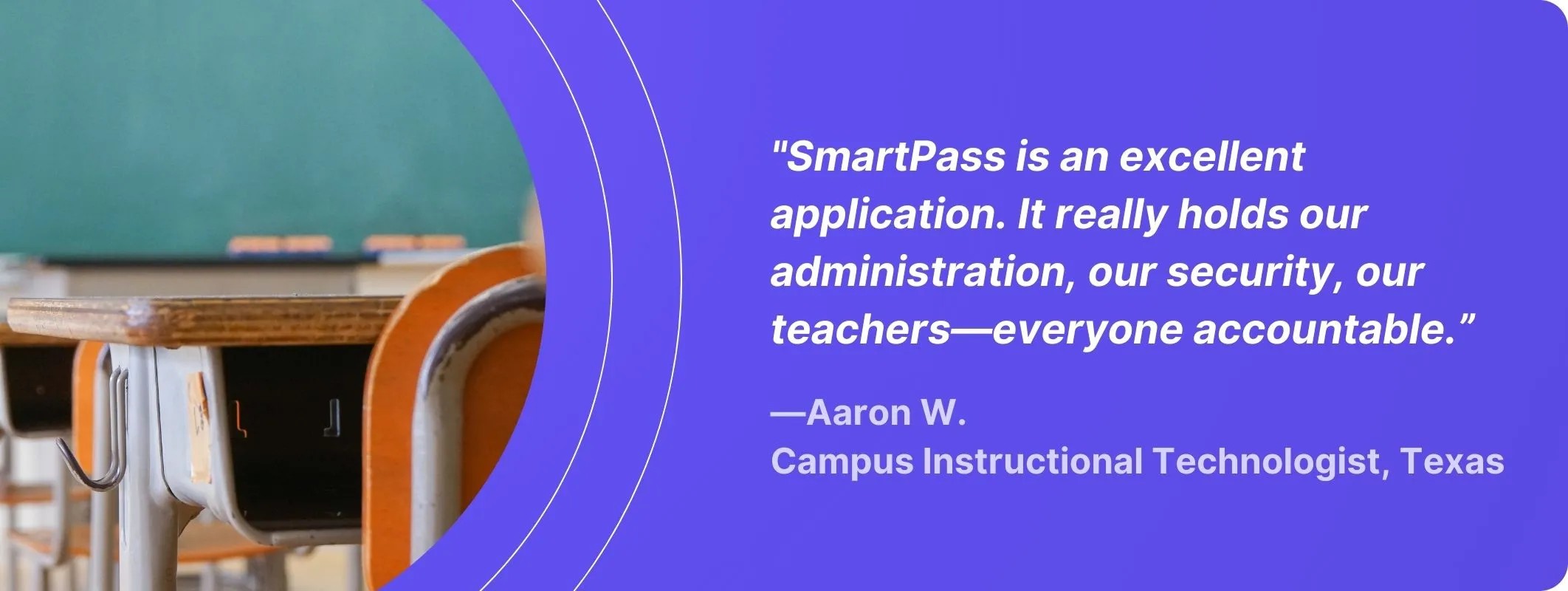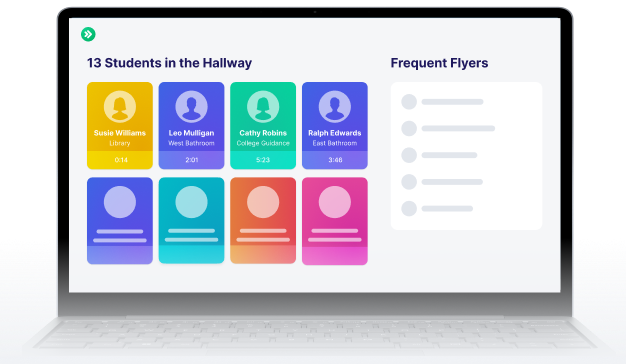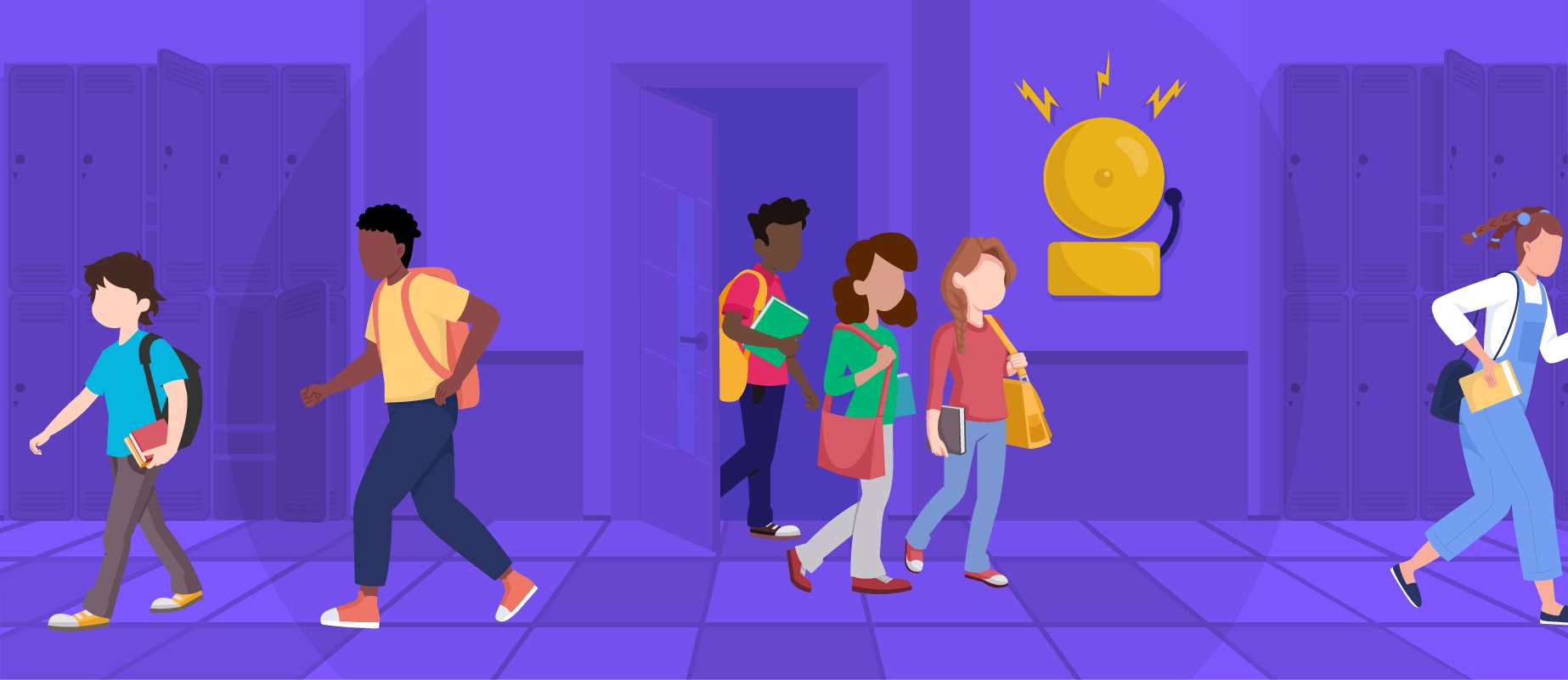In the News: Enhancing Safety in Schools Across Minnesota
Read the Story
SmartPass Co-Founders Listed on Forbes 30 Under 30
Read the Story

Caitlin Kindred
.avif)

Imagine for just a moment that you could press pause on your school. While everyone and everything is still, consider these three questions:
In education, we often find ourselves balancing rules, routines, and expectations we set for our students with the need for flexibility. As middle and high school administrators, maintaining effective school systems and routines can sometimes feel like a tightrope walk. There comes a point in the school year when it feels like the rules and routines put in place at the start of the year aren’t working anymore as students start to get… comfortable.
The increase in negative student behaviors is no secret. According to two reports published by the Education Advisory Board (EAB)* in early 2023,
When rules and procedures start to fall apart and consistency becomes a thing of the past, students know it. Behavior problems grow roots, teachers get frustrated when they’re “the only ones” enforcing rules, and school culture takes a turn for the worse.
There are ways that school leadership can ensure that students and staff follow the rules with fidelity. The best part? You already have most of the tools to make it happen in your teacher toolbox.
Before we jump to that, I would offer the following: How do you know they are? Has it just “been a day”? Was the school routine off on Tuesday and the kids are still unsettled? (Is there a full moon? No seriously, go check.) Certainly, you might be seeing a spike in the same incident type, but that doesn’t mean the rule is being ignored.
Remember that data-driven practices aren’t limited to the classroom. In fact, they apply to every part of a school’s campus. By reviewing your school’s existing policies and procedures, you gain valuable insights into what’s working and what isn’t. In doing so, you ensure that your rules not only remain relevant but also adapt to the evolving needs of your student population.
Here are two key considerations for evaluating your school rules and routines for effectiveness.
Gathering data on student behavior incidents is a fundamental step in the assessment process. This information provides crucial insights into the effectiveness of your school's rules and routines. By analyzing incident data, you can identify trends, patterns, and hotspots that may show underlying issues.
Maybe the data shows that the behavior(or behaviors) in question isn’t an issue. And yet, you can’t shake the feeling that it really is an issue. What then?
Even the best rules put in place by administrators will fail if teachers can’t enforce them consistently. Teachers want to enforce school expectations; in fact, most teachers get frustrated when they are the “only ones” following the new rules. (If I had a dollar for every time I abandoned a rule because no one else followed it… 🙄)
This is why collaboration between school leaders and teachers is essential in determining which school rules and routines are relatively easy for teachers to enforce consistently. By working together, you can create policies that support educators in maintaining a positive classroom environment.
Again, think about the steps necessary to enforce the rule! What happens after an incident occurs? Can the teacher address it with an email home? Does it require a phone call? And then 20 minutes of paperwork? If it adds any more food to your teachers’ plates, it’s not getting enforced without high levels of buy-in.
When I was in the classroom, I noticed a shift in behavior about 4-6 weeks into the school year. Everyone—students and staff alike—had settled into a comfortable routine and the behavior honeymoon was clearly over.
During that post-honeymoon phase (a.k.a the rest of the school year), it’s crucial to enforce rules and procedures with fidelity to ensure that the post-honeymoon period doesn’t devolve into a nightmare. Here’s how to make it happen.
Open lines of communication are critical. Encourage teachers, staff, and students to provide feedback on what's working and what's not. Official feedback tools, such as school climate surveys like this one created by the U.S. Department of Education School Climate Surveys (EDSCLS) or others offered by social-emotional curricula publishers are an option. Otherwise, informal measures, such as short web questionnaires and suggestion boxes, can help identify issues early on.
And don't overlook the role of parents and the wider community. Keeping them informed about school rules and the importance of adherence fosters a sense of shared responsibility.
Continue to analyze data on student behavior incidents and rule adherence. Remember all that time you spent analyzing behavior trends? Now’s the time to actually use that data. Analyzing these trends can provide insights into the areas that need attention. This blog from PBISApps by Melissa Nantais, PhD offers great tips for collecting and analyzing student behavior data and includes practical tips to guide your efforts.
Every educator knows that schools both create routines and require flexibility. The same goes for rules and routines: they should never be set in stone. School leaders must be willing to adapt and refine them based on feedback from all stakeholders and data analysis. If certain rules are consistently disregarded, it might be time to revisit and adjust them, or even get rid of them altogether.
That thing I mentioned in number 3? Make it a regular thing. Establish a routine for reviewing and revising school rules and routines. Annual or semesterly reviews can ensure that policies remain relevant and effective.
Yes, you have rules on your walls and every teacher walks through them at the start of the year. But how explicit were those walkthroughs?
For example, “be respectful” seems like an easy rule to understand, right? But in Teacher A’s room, “be respectful” means “treat everyone with kindness.” Meanwhile, in Teacher B’s room, “be respectful” means “treat everyone with kindness and show up to class on time, with your materials.”
Any expectations you have for students should be explicit and straightforward. Don’t leave room for misinterpretation and the “but I didn’t know that was part of the rule, Miss!” excuses. If “be ready for class” is a school rule, demonstrate what “being ready” looks like. Include words, pictures, memes—whatever you need to use to make the expectation crystal clear.
Don’t forget that it’s absolutely essential for adults to model the behavior they wish to see. If teachers are asked to enforce a policy, administrators have to 1) commit to living by that policy and 2) support teachers and staff who enforce it. Failure to model a rule is the fastest way to show that the rule doesn’t matter. And failure to enforce it shows your teachers that you aren’t on their side.
Support your teaching staff with ongoing professional development. Offer training sessions and practical resources to help teachers enforce routines and manage classrooms effectively. Sharing best practices is incredibly beneficial.
Also, a general rule of thumb here: anyone who attends PD needs to walk away with something of value, preferably in the form of an action they can take to improve their classroom lives immediately. Think templates, a new review game to play, etc.
Establish a mentoring program or encourage peer support among teachers. Experienced educators can provide guidance and share their strategies with newer teachers as they navigate classroom management challenges. And don’t discount the value that newer teachers bring to the table! Create opportunities for them to support more experienced teachers, too.
It sounds strange, but positive reinforcement works with adults just as much as it does with students (but skip the sticker charts for your staff 😉). Recognize and reward students and staff who consistently follow school rules and routines. Positive reinforcement is a powerful motivator. Acknowledging and celebrating adherence to these guidelines both encourages stragglers and creates a more positive school culture.
Be mindful of the method of recognition. It’s important to do so in a way that honors that individual. “How do you like to receive acknowledgment for a job well done?” is a good question to ask on staff or student intake forms and surveys.
Technology is a powerful ally in maintaining effective school systems and routines with efficiency. Ask your staff to share their favorite tech tools and websites for simplifying their teaching tasks. Ask students, too. You’ll build community by getting people talking, and likely discover something new.
SmartPass, a digital hall pass solution, is one such tool. It simplifies and automates student movement, reducing the burden on both teachers and students. SmartPass not only makes it easy for students to request and receive permission to leave the classroom but also offers real-time updates, which can help enforce rules and procedures.
By incorporating technology like SmartPass into your school's routine management, you not only make it easier for teachers and students to adhere to established policies but also collect valuable data for continuous improvement.
NCES data indicates that during the 2020-21 school year, 67% of public school teachers agreed that other teachers at their school enforced their school’s rules. And 83% percent agreed that the principal did the same. In general, middle and high school teachers reported lower percentages of rule enforcement than their elementary school counterparts. These numbers prove that consistency is a problem for school staff.
As for correcting the behaviors that break the rules, the EAB Student Behavior Report* notes that nearly 40% of survey respondents agree that district and school administrators’ messaging on how and when to follow district behavior management strategies is inconsistent, putting teachers in between administrators and families.
People get busy and tasks slip through the cracks. It happens. Bringing your team together to discuss why a particular policy exists can make it top-of-mind again. This is a great time to get feedback, too. Your team can ask questions, hammer out kinks, and come up with ways to simplify the processes around policies to create consistency.
Consistency is paramount, and it starts with administrators. When administrators, teachers, and staff consistently enforce the rules, it sets an example for students to follow. Students know they can’t play one teacher off of another. Perhaps more importantly, students have a sense of fairness around school rules, which allows them to trust their school adults. Teachers feel genuinely supported by their colleagues and administrators (they can trust their school adults, too). And the space is clear for your school’s culture to thrive.
Assessing and enhancing the effectiveness of school rules and routines is an ongoing process. It requires committing to data-driven decision-making, collaborating with other school leaders and teachers, and using technology to streamline processes. These steps help create a consistent, productive, and positive learning environment for your entire school community.
Over 2,000 schools and 1 million users trust SmartPass to support policies and procedures around student movement. If you’d like to learn more about how SmartPass can meet the unique needs of your school, click here to meet with a member of our team.
___________
*Note: Readers may access the EAB’s “Student Behavior" Survey and “2023 Voice of the Superintendent” reports for free by completing the form on each webpage. Access the EAB’s summary of those reports or read the press release for a summary of the findings.



.jpg)